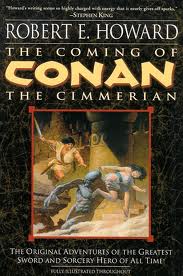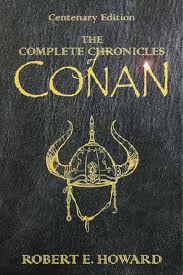Under the Hood with Robert E. Howard
I remain in the literary salt mines this week, so I’m reprinting an article I wrote for Black Gate back in 2012.
 When I tell people what a great writer Robert E. Howard was, a lot of them don’t seem to believe me. If they only know him through depictions of Conan or, worse, rip-offs, then they think Howard’s writing is all about a dull guy in a loin cloth fighting monsters and lots of straining bosoms. It’s not that Robert E. Howard thought himself above describing a lithesome waist or a wilting beauty, especially if he needed to make a quick buck, it’s just that there’s a lot more going on in a Conan story than his imitators took away.
When I tell people what a great writer Robert E. Howard was, a lot of them don’t seem to believe me. If they only know him through depictions of Conan or, worse, rip-offs, then they think Howard’s writing is all about a dull guy in a loin cloth fighting monsters and lots of straining bosoms. It’s not that Robert E. Howard thought himself above describing a lithesome waist or a wilting beauty, especially if he needed to make a quick buck, it’s just that there’s a lot more going on in a Conan story than his imitators took away.
It’s easy to pull some samples of great action writing from Robert E. Howard. I’ve done it before, and I could easily do it again here. Only a handful of writers can approach him in that field, and almost none are his equal.
He was also a master of headlong, driving pace. That can be hard to showcase without insisting you read an entire story, so today I want to show readers who seem unaware of his work (or those who are uninterested) a few more reasons why those of us in the know revere him so highly.
Here in one of his historical stories, ”Lord of Samarcand,” is the Scotsman, or Frank, as the easterners call any from Europe, Donald MacDeesa, riding to the court of Tamarlane the Great. See how swiftly, how easily, Howard conjures the scene in all its splendor with just a few well-chosen words, as though he’s panning a camera as MacDeesa rides.
The Frank’s wonder grew; the cities of the West were hovels compared to this. Past academies, libraries, and pleasure-pavilions they rode, and Ak Boga turned into a wide gateway, guarded by silver lions. There they gave their steeds into the hands of silk-sashed grooms, and walked along a winding avenue paved with marble and lined with slim green trees. The Scotsman, looking between the slender trunks, saw shimmering expanses of roses, cherry trees and waving exotic blossoms unknown to him, where fountains jetted arches of silver spray. So they came to the palace, gleaming blue and gold in the sunlight, passed between tall marble columns and entered the chambers with their gilt-worked arched doorways, and walls decorated with delicate paintings of Persian and Cathayan artists, and the gold tissue and silver work of Indian artistry (Howard, 89).
 Howard had far more range and depth than his detractors ever want to give him, and he created many compelling characters. But let’s turn our attention back to Howard’s most famous creation, Conan, because I mean to show you that he’s more than is assumed from the usual portrayals.
Howard had far more range and depth than his detractors ever want to give him, and he created many compelling characters. But let’s turn our attention back to Howard’s most famous creation, Conan, because I mean to show you that he’s more than is assumed from the usual portrayals.
First, he’s not unstoppable and unchangeable, nor did he stride forward into his first adventures with the same skilled confidence he evidences in stories set later. He is powerful and courageous in “The Tower of the Elephant,” but he is new to cities, as these two excerpts show.
The Cimmerian glared about, embarrassed at the roar of mocking laughter that greeted this remark. He saw no particular humor in it, and was too new to civilization to understand its discourtesies. Civilized men are more discourteous than savages because they know they can be impolite without having their skulls split, as a general thing (31).
He had entered the part of the city reserved for the temples. On all sides of him they glittered white in the starlight – snowy marble pillars and golden domes and silver arches, shrines of Zamora’s myriad strange gods. He did not trouble his head about them; he knew that Zamora’s religion, like all things of a civilized, long-settled people, was intricate and complex, and had lost most of the pristine essence in a maze of formula and rituals. He had squatted for hours in the courtyards of the philosophers, listening to the arguments of theologians and teachers, and come away in a haze of bewilderment, sure of only one thing, and that, that they were all touched in the head.
His gods were simple and understandable; Crom was their chief, and he lived on a great mountain, whence he sent forth dooms and death. It was useless to call on Crom, because he was a gloomy, savage god, and he hated weaklings. But he gave a man courage at birth, and the will and might to kill his enemies, which, in the Cimmerian’s mind, was all any god should be expected to do (32).
Here, later in the same story, Conan and the master thief Taurus are scaling a tower where they seek a fabulous treasure. Feast ye upon the glorious description:
The cord swayed and turned on itself, but the climbers were not hindered; both had made more difficult climbs before. The jeweled rim glittered high above them, jutting out from the perpendicular of the wall, so that the cord hung perhaps a foot from the side of the tower – a fact which added greatly to the ease of the ascent.
Up and up they went, silently, the lights of the city spreading out further and further to their sight as they climbed, the stars above them more and more dimmed by the glitter of the jewels along the rim. Now Taurus reached up a hand and gripped the rim itself, pulling himself up and over. Conan paused a moment on the very edge, fascinated by the great frosty jewels whose gleams dazzled his eyes – diamonds, rubies, emeralds, sapphires, turquoises, moonstones, set thick as stars in the shimmering silver. At a distance their different gleams had seemed to merge into a pulsing white glare; but now, at close range, they shimmered with a million rainbow tints and lights, hypnotizing him with their scintillations (39).
 In the sword-and-sorcery clonans that followed the Cimmerian’s footsteps, there was little variety and less depth. But Conan does not stride forward, unthinking, and hack everything before him. Here he comes upon a chamber where he hoped to find the treasure, and finds instead a frightening, humanoid monster. On the off chance you’ve never read this story — because you should, and I don’t want to spoil it for you — I’m cutting most of its description, and just showing you Conan as he realizes humans have blinded and imprisoned this being.
In the sword-and-sorcery clonans that followed the Cimmerian’s footsteps, there was little variety and less depth. But Conan does not stride forward, unthinking, and hack everything before him. Here he comes upon a chamber where he hoped to find the treasure, and finds instead a frightening, humanoid monster. On the off chance you’ve never read this story — because you should, and I don’t want to spoil it for you — I’m cutting most of its description, and just showing you Conan as he realizes humans have blinded and imprisoned this being.
…and Conan’s gaze strayed to the limbs stretched on the marble couch. And he knew the monster would not rise to attack him. He knew the marks of the rack, and the searing brand of the flame, and tough-souled as he was, he stood aghast at the ruined deformities which his reason told him had once been limbs as comely as his own. And suddenly all fear and repulsion went from him, to be replaced by a great pity. What this monster was, Conan could not know, but the evidences of its sufferings were so terrible and pathetic that a strange aching sadness came over the Cimmerian, he knew not why. He only felt that he was looking upon a cosmic tragedy, and he shrank with shame, as if the guilt of a whole race were laid upon him (45).
Howard seldom failed to entertain, and at his best, he was not just good, he was great – he stands as one of the best adventure writers we’ve ever had. There is much to be gleaned from his craft, and much enjoyment to be found in his writing. If you’re exploring for the first time though, you’ll have to make allowances for conventions from Howard’s time, which means some sexism or racism – although, as Howard does not himself seem to have been racist or sexist, you’ll also come upon depictions of women and non-whites that defy stereotypes. Sometimes there are also the usual genre conventions you’ll encounter from magazine fiction of the period; shorter stories, for one, and the use sometimes of a villain monologue or an info dump through conversation to move the plot ahead. Yet even when these aspects are there, Howard’s strengths drive the story forward.
If you’re new to him, I’d suggest the new Del Rey trade paperback, The Best of Robert E. Howard Volume 2, Grim Lands, from which all these excerpts were taken, although if you want Conan alone, any one of the three Del Rey Conan volumes will see you in good stead.
0 Comments